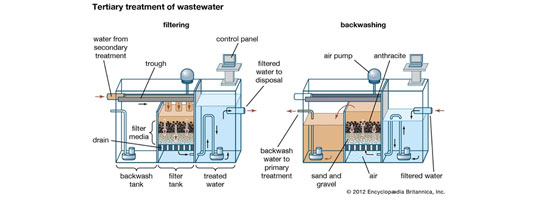Sewage Treatment Plant:
Domestic sewage is slightly more than 99.9 percent water by weight. The rest, less than 0.1 percent, contains a wide variety of dissolved and suspended impurities. Although amounting to a very small fraction of the sewage by weight, the nature of these impurities and the large volumes of sewage in which they are carried make disposal of domestic wastewater a significant technical problem. The principal impurities are putrescible organic materials and plant nutrients, but domestic sewage is also very likely to contain disease-causing microbes. Industrial wastewater usually contains specific and readily identifiable chemical compounds, depending on the nature of the industrial process. Storm sewage carries organic materials, suspended and dissolved solids, and other substances picked up as it travels over the ground.
The amount of putrescible organic material in sewage is indicated by the biochemical oxygen demand, or BOD; the more organic material there is in the sewage, the higher the BOD, which is the amount of oxygen required by microorganisms to decompose the organic substances in sewage. It is among the most important parameters for the design and operation of sewage treatment plants. Industrial sewage may have BOD levels many times that of domestic sewage. The BOD of storm sewage is of particular concern when it is mixed with domestic sewage in combined sewerage systems.
Dissolved oxygen is an important water quality factor for lakes and rivers. The higher the concentration of dissolved oxygen, the better the water quality. When sewage enters a lake or stream, decomposition of the organic materials begins. Oxygen is consumed as microorganisms use it in their metabolism. This can quickly deplete the available oxygen in the water. When the dissolved oxygen levels drop too low, trout and other aquatic species soon perish. In fact, if the oxygen level drops to zero, the water will become septic. Decomposition of organic compounds without oxygen causes the undesirable odours usually associated with septic or putrid conditions.
There are three levels of wastewater treatment: primary, secondary, and tertiary (or advanced). Primary treatment removes about 60 percent of total suspended solids and about 35 percent of BOD; dissolved impurities are not removed. It is usually used as a first step before secondary treatment. Secondary treatment removes more than 85 percent of both suspended solids and BOD. A minimum level of secondary treatment is usually required in the United States and other developed countries. When more than 85 percent of total solids and BOD must be removed, or when dissolved nitrate and phosphate levels must be reduced, tertiary treatment methods are used. Tertiary processes can remove more than 99 percent of all the impurities from sewage, producing an effluent of almost drinking-water quality. Tertiary treatment can be very expensive, often doubling the cost of secondary treatment. It is used only under special circumstances.


